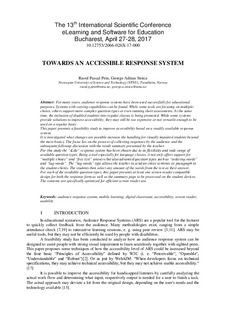Towards an Accessible Response System
Journal article
Published version
Permanent lenke
http://hdl.handle.net/11250/2492498Utgivelsesdato
2017Metadata
Vis full innførselSamlinger
- Institutt for allmennfag [15]
- Publikasjoner fra CRIStin - NTNU [37703]
Sammendrag
For many years, audience response systems have been used successfully for educational purposes. Systems with varying capabilities can be found. While some tools are focusing on multiplechoice, others support more complex question types or even running short assessments. At the same time, the inclusion of disabled students into regular classes is being promoted. While some systems provide solutions to improve accessibility, they may still be too expensive or not versatile enough to be used on a regular basis. This paper presents a feasibility study to improve accessibility based on a readily available response system. It is investigated what changes are possible increase the handling for visually impaired students beyond the mere basics. The focus lies on the process of collecting responses by the audience and the subsequent followup discussion with the result summary presented by the teacher. For this study the “iLike” response system has been chosen due to its flexibility and wide range of available question types. Being a tool especially for language classes, it not only offers support for “multiple choice” and “free text” answers but also advanced question types such as “ordering words” and “tag words”. The “tag words” type allows the teacher to send an entire sentence or paragraph to the student clients. The students then select any amount of the words from the text as their answer. For each of the available question types, this paper presents at least one screen reader compatible design for both the response form as well as the summary page to be processed on the student devices. The contents are specifically optimized for efficient screen reader use.
